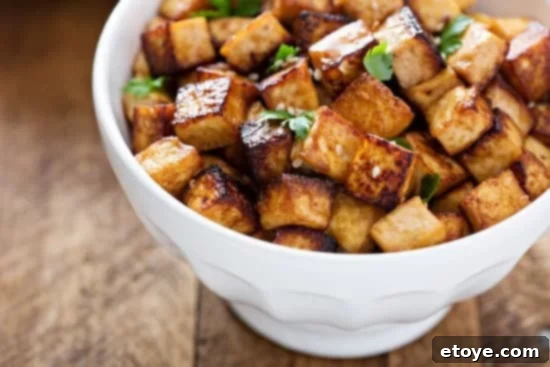Mastering Tofu: Your Ultimate Guide to Cooking This Versatile Plant-Based Protein
Tofu, often misunderstood and sometimes underestimated, is truly a culinary marvel. While some perceive it as bland, I see it as an extraordinary blank canvas, eagerly awaiting a chef’s artistic touch. Its true beauty lies in its incredible adaptability, allowing it to transform into a myriad of textures and flavors. From irresistibly crispy golden bites to smoky, perfectly grilled cubes, tofu possesses the remarkable ability to don countless delicious hats. As a cornerstone of plant-based cuisine, it offers a healthy, sustainable, and endlessly customizable protein source that can elevate any meal.
For years, I’ve championed tofu’s potential, moving beyond its simple form to unlock its dynamic character. Today, we’re embarking on an exciting culinary journey, delving into the most effective and delicious ways to prepare this unassuming ingredient. We’ll explore various cooking techniques, each designed to bring out a unique charm and transform your perception of tofu forever. Get ready to discover your new favorite way to enjoy this versatile protein!
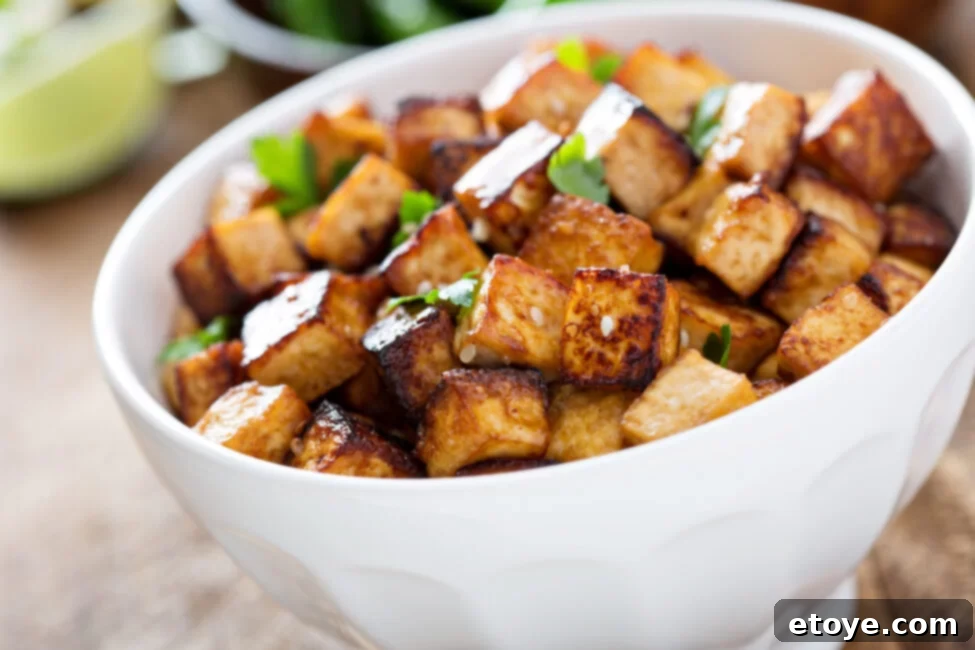
The Rich History and Global Appeal of Tofu
To truly appreciate tofu, it’s worth exploring its origins. This humble bean curd, as it’s often known, has been a staple in Asian diets for over 2,000 years. Its journey began in ancient China during the Han dynasty, with a charming legend crediting its accidental discovery to a cook who mistakenly mixed fresh soy milk with nigari, a natural coagulant derived from seawater. The result was a soft, protein-rich curd that quickly became a dietary cornerstone.
From its Chinese birthplace, tofu gracefully spread across Asia, becoming an integral part of diverse culinary traditions. Japanese cuisine delicately incorporates it into comforting miso soups, while Koreans spice it up in hearty stews. In Southeast Asia, it’s often fried to a delightful crisp, adding texture and substance to various dishes. Each culture embraced and adapted tofu, showcasing its remarkable versatility and proving its ability to absorb and enhance local flavors.
Tofu is far from just a historical relic; its journey continues with increasing momentum. In our modern world, with a growing global emphasis on plant-based diets, sustainable eating, and health-conscious choices, this ancient food has found renewed prominence on dining tables worldwide. Its neutral flavor profile and impressive nutritional benefits – being an excellent source of protein, essential amino acids, iron, and calcium – make it a perfect fit for contemporary lifestyles. The story of tofu is a powerful testament to how food, even the simplest, can weave together tales of cultures, innovative discoveries, and enduring traditions, evolving to meet the demands of every era.
The Foundation of Delicious Tofu: Pressing and Preparation
Before diving into any cooking method, mastering the initial preparation of tofu is crucial for achieving the best results. The key to truly delicious tofu lies in removing excess moisture, allowing it to absorb marinades more effectively and crisp up beautifully during cooking.
Choosing the Right Tofu for Your Recipe
- Firm or Extra-Firm Tofu: These varieties are ideal for baking, pan-frying, grilling, and scrambling. Their dense texture holds up well to various cooking methods, providing a satisfying chew. They contain the least amount of water, making them easier to press.
- Medium Tofu: Slightly softer than firm tofu, medium tofu can still be used for gentle stir-fries or dishes where you prefer a softer bite. It’s also excellent for making sauces or dressings.
- Soft or Silken Tofu: These delicate types are best reserved for creamy sauces, dressings, smoothies, desserts, or adding to soups where they dissolve to create a smooth texture. They will not hold their shape well for baking or frying.
The Essential Step: Pressing Tofu for Optimal Flavor and Texture
Pressing tofu is non-negotiable for most recipes seeking crispy textures and deep flavor absorption. Tofu is packaged in water, and this excess moisture prevents it from achieving a golden, crunchy exterior and dilutes any marinade you might add. Removing this water creates a denser block that is far more receptive to seasonings and heat.
There are a couple of effective ways to press tofu:
- The DIY Method: Remove the tofu from its package and drain the water. Wrap the block in several layers of clean kitchen towels or paper towels. Place it on a cutting board, then top it with something heavy – a cast-iron skillet, a stack of cookbooks, or even a few cans of food. Let it press for at least 15-30 minutes, or up to an hour for extra-firm results. The longer you press, the more water is removed, leading to a firmer, crispier final product.
- Using a Tofu Press: For frequent tofu cooks, a dedicated tofu press is a worthwhile investment. These gadgets apply even pressure, making the process effortless and highly efficient, often pressing a block dry in under 15 minutes.
Once pressed, your tofu is ready to transform! This simple step makes all the difference in achieving that coveted crispy texture and ensuring your tofu dishes are bursting with flavor.
How to Bake Tofu: The Path to Effortless Crispy Goodness
Baking tofu in the oven is one of the easiest and most hands-off methods to achieve a beautifully crisp exterior and a tender, chewy interior. This technique leverages the oven’s consistent, dry heat to evaporate moisture, transforming bland tofu into delectable, golden-brown bites that are perfect for salads, stir-fries, or enhancing any Buddha Bowl.
Baking Tofu to Perfection
Prepare the Tofu: Start with firm or extra-firm tofu. Remove it from the package, drain excess water, and most importantly, press it thoroughly using one of the methods described above for at least 15-30 minutes. This step is crucial for crispy results.
Preheat and Prep: Preheat your oven to 425°F (220°C). Line a baking sheet with parchment paper to prevent sticking and ensure easy cleanup.
Slice and Season: Slice the pressed tofu into 1.5-inch cubes (or desired shape). In a bowl, toss the tofu with 1 tablespoon of olive oil, 1 tablespoon of soy sauce (or tamari/coconut aminos for gluten-free options). For added depth, consider a pinch of garlic powder, onion powder, and a dash of paprika. The oil helps with browning, while the soy sauce infuses savory flavor.
Coat for Crispiness: Add 1 tablespoon of cornstarch, arrowroot powder, or tapioca starch to the bowl. Toss until the tofu cubes are completely coated. The starch creates a thin, crispy shell around the tofu when baked, locking in moisture and ensuring that coveted crunch.
Bake to Golden: Arrange the coated tofu in a single layer on the prepared baking sheet, ensuring pieces don’t touch, which allows for even air circulation and crisping. Bake for 25-30 minutes, flipping the tofu halfway through to ensure all sides are evenly golden and crispy.
Serve and Enjoy: Remove the baked tofu from the oven. For an extra flavor boost, toss the warm, crispy cubes in your favorite Buddha bowl sauce, a vibrant peanut sauce, or a zesty lemon-tahini dressing. These oven-crisped delights will surprise even the most tofu-skeptical eater.
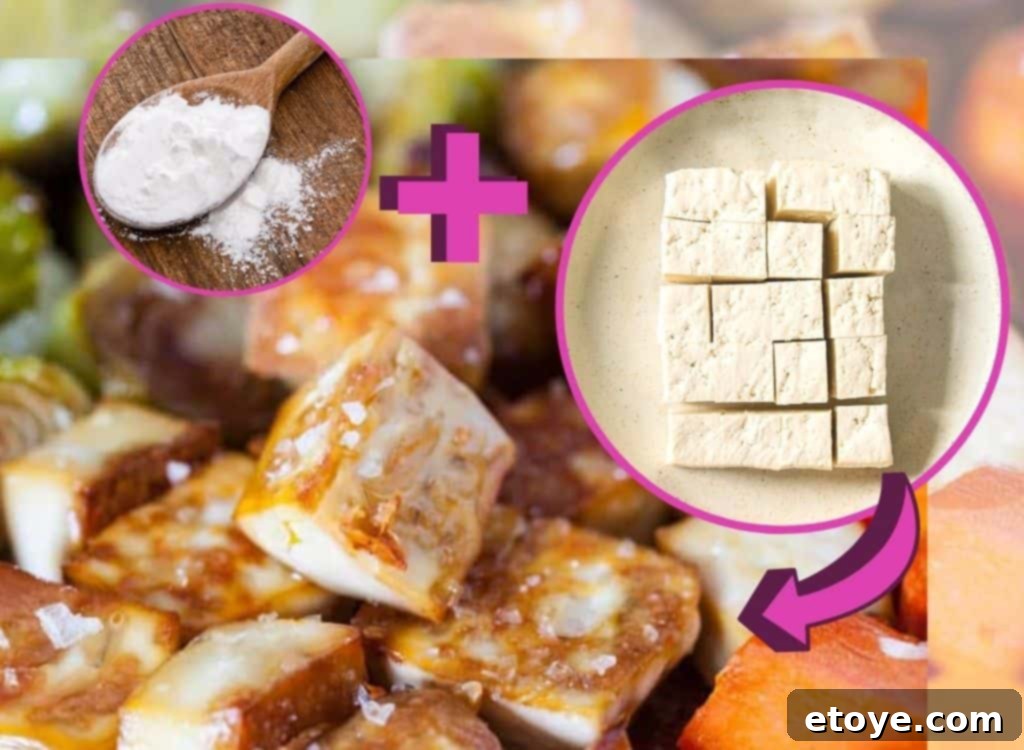
How to Pan Sear Tofu: Achieving the Perfect Golden Crust
Pan-searing is a fantastic method for developing a truly delicious contrast in tofu: a perfectly crispy, golden-brown crust on the outside and a wonderfully tender, melt-in-your-mouth interior. By utilizing the pan-sear method, you’re ensuring that each tofu cube develops a flavorful, crunchy exterior, thanks to the Maillard reaction, while preserving its soft, yielding heart. This technique is quick, efficient, and yields impressive results.
Pan-Searing Tofu for Maximum Flavor and Texture
Tofu Preparation is Key: Begin with firm or extra-firm tofu. Remove it from its packaging, drain thoroughly, and press diligently for at least 15-30 minutes to eliminate as much moisture as possible. This step is critical for preventing splattering and achieving maximum crispness.
Cube and Coat: Slice the pressed tofu into 1.5-inch cubes. In a bowl, toss the tofu with 1 ½ tablespoons of cornstarch, arrowroot powder, or tapioca starch until each piece is evenly coated. This starch layer is essential for creating that desirable crispy crust.
Heat the Pan: Place a large skillet (cast iron or non-stick works best) over medium-high heat. Add a generous amount of olive oil or another high-heat cooking oil (like avocado or grapeseed oil) – enough to lightly coat the bottom of the pan, typically 2-3 tablespoons. Allow the oil to heat until it shimmers but isn’t smoking.
Sear in Batches: Carefully add the coated tofu cubes to the hot pan in a single layer, ensuring not to overcrowd the pan. Cooking in batches allows each piece to sear properly rather than steam. Cook for 2-3 minutes on each side until the exterior is beautifully golden-brown and crisp. Use tongs to gently flip the tofu to ensure even browning on all sides.
Finish and Serve: Once all sides are golden and crispy, remove the pan from the heat. You can either serve the crispy tofu immediately as is, or for an added burst of flavor, toss the warm tofu with your favorite Buddha bowl sauce, a spicy peanut sauce, a sweet chili glaze, or a savory teriyaki. Pan-seared tofu is perfect in wraps, alongside stir-fried vegetables, or as a protein boost in any salad.
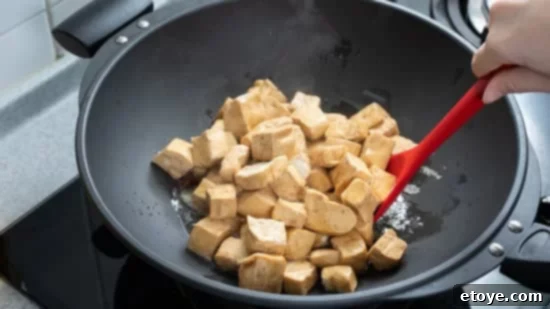
How to Grill Tofu: Infusing Smoky Flavors and Perfect Char
Grilling isn’t just reserved for meats; tofu is an outstanding candidate for the smoky, char-kissed flavors that only a grill can provide. When properly prepared, tofu transforms on hot grates, developing coveted grill marks and a unique depth of flavor. Combining grilled tofu with colorful fruits or vegetables on skewers creates a playful mix of textures and tastes that absolutely screams summer and healthy eating.
Grilling Tofu for a Delicious Outdoor Experience
Press and Cube: Start with firm or extra-firm tofu. Remove it from its package, drain the water, and press it meticulously for at least 30 minutes. The drier the tofu, the better it will absorb marinades and hold its shape on the grill. Slice the pressed tofu into substantial 1.5-inch cubes or thicker slabs that won’t fall through the grates.
Marinate for Flavor: While not explicitly in the original steps, marinating tofu is essential for grilling to infuse flavor and moisture. Create a flavorful marinade (e.g., teriyaki, BBQ, lemon-herb, soy-ginger). Soak the tofu cubes for at least 30 minutes, or preferably several hours, in a sealed bag or shallow dish. This step prevents the tofu from drying out and ensures it’s packed with flavor.
Prepare the Grill: Preheat your grill to medium-high heat. Once hot, clean the grates thoroughly with a grill brush. Then, oil the grill grates exceptionally well by dipping a folded paper towel in cooking oil (like avocado or grapeseed) and carefully wiping the grates with tongs. This prevents the tofu from sticking.
Skewer the Tofu: Carefully thread the marinated tofu onto skewers, alternating with your favorite grill-friendly vegetables. Bell peppers, red onions, zucchini, cherry tomatoes, and mushrooms are excellent choices. For a delightful sweet and savory twist, add chunks of pineapple or firm peaches – they caramelize beautifully. Don’t overload the skewers; leave a little space between items for even cooking.
Grill to Perfection: Place the skewers on the preheated, oiled grill grates. Cook for approximately 6-8 minutes, turning occasionally to char each side lightly and evenly. The tofu should develop distinct grill marks and a slightly firm exterior. Keep an eye on the tofu to prevent burning, as marinades containing sugars can caramelize quickly.
Serve with Sauce: Remove the skewers from the grill. For an extra burst of flavor, drizzle your favorite Buddha bowl sauce, a fresh chimichurri, or more of your grilling marinade (ensure it’s boiled if it touched raw tofu) over the warm tofu and veggies. Grilled tofu skewers make a fantastic main course, a vibrant side dish, or an excellent addition to summer salads.
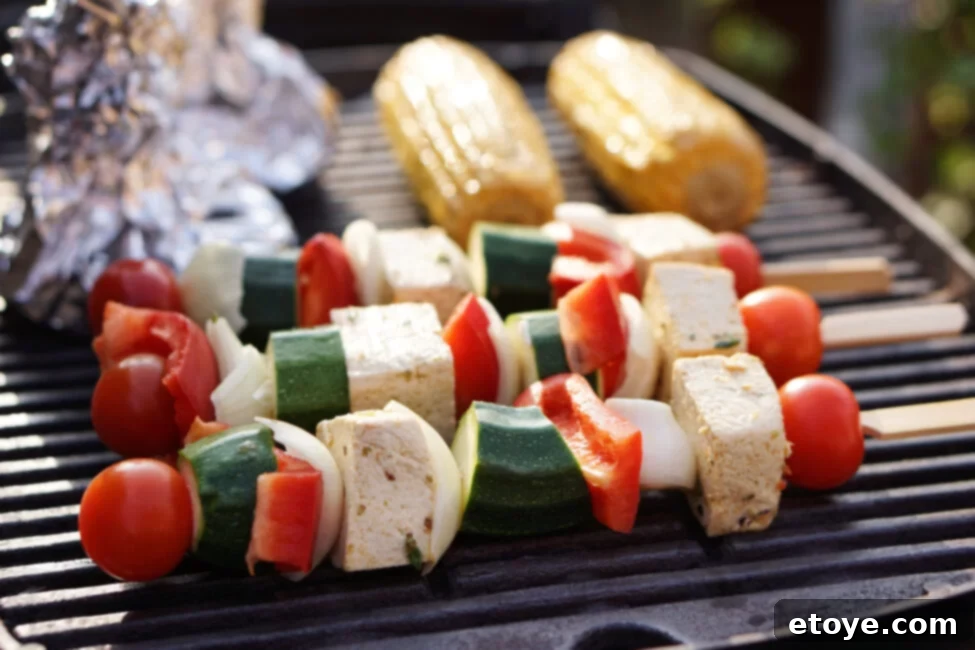
Vegetarian Barbecue, marinated vegetables and tofu kebabs on a grill
Exploring Smoked Tofu: A Shortcut to Deep Flavor
Among the many wonderful varieties of tofu, smoked tofu holds a special place in my kitchen. If there’s one thing I’ve discovered over the years, it’s that tofu isn’t just a staple; it’s an adventure waiting to happen. Smoked tofu is one such gem that consistently piques my culinary curiosity and delight. I absolutely adore using packaged smoked tofu; its distinct, robust smoky flavor, naturally embedded within its layers, effortlessly elevates even the simplest of dishes, adding an irresistible depth and character.
If you’ve never tried smoked tofu before, you’re in for a true treat. It carries a delightful aroma reminiscent of a cozy evening by a campfire or a classic backyard barbecue, bringing a comforting warmth to any meal. The best part? It’s incredibly convenient and a cinch to cook with! Unlike traditional tofu, smoked tofu often doesn’t require pressing or long marinating hours. It’s pre-cooked and pre-seasoned, making it a fantastic ingredient for quick meals and flavor-packed dishes. Here’s how we love to bring out the best in smoked tofu:
Simply slice the tofu into ½-inch slices, pat them very dry on both sides with paper towels, and pan-fry them with a little bit of neutral cooking oil (like canola, sunflower, or avocado oil) over medium heat until beautifully browned and slightly crispy on both sides. This simple pan-frying method enhances its texture and further develops its inherent smoky flavor. Smoked tofu is excellent added to salads, sandwiches, scrambles, pasta dishes, or enjoyed straight out of the pan as a savory snack.

The Art of Marinating Tofu: Our Ultimate Method for Flavor Immersion
Tofu, often dubbed the chameleon of the culinary world, possesses an unparalleled ability to absorb flavors. By marinating it, you’re not just coating the surface; you’re embedding rich, vibrant tastes deep into its core, transforming its subtle flavor into something truly extraordinary. Our ultimate method for cooking tofu harnesses the transformative power of marinades, ensuring that each bite is not just seasoned but bursting with flavor. It’s a complete journey of taste, from the initial flavor absorption of your chosen sauce to the crispy, caramelized exterior achieved through careful pan-frying. This technique truly showcases tofu at its finest, delivering a consistently delicious and satisfying experience. Try this at home to unlock tofu’s full flavor potential:
Our Favorite Marinated Tofu Method
Prepare and Press: Begin with firm or extra-firm tofu, drained and thoroughly pressed for at least 30 minutes. The drier the tofu, the more marinade it will absorb. Slice it into desired shapes – 1/2-inch thick slices or 1.5-inch cubes work well.
Create Your Marinade: In a large bowl or a resealable bag, add ¼ to ½ cup of your favorite flavorful sauce. This could be a classic soy-ginger, a spicy sriracha-lime, a smoky BBQ, a zesty lemon-herb, or a rich peanut sauce. Consider adding ingredients like minced garlic, grated ginger, rice vinegar, maple syrup, or a dash of sesame oil to enhance the flavor profile.
Marinate the Tofu: Carefully add the pressed tofu slices or cubes to the bowl or bag with the marinade. Ensure all pieces are thoroughly coated. If using slices, be gentle as they can be delicate. Marinate for at least 30 minutes to allow initial flavor penetration, or for a truly deep and robust taste, marinate overnight in the refrigerator. The longer the marination, the more flavorful the tofu will become.
Prepare for Cooking: When you’re ready to cook, gently remove the tofu from the marinade. Lightly wipe off any excess marinade with a paper towel. While some marinade is good for flavor, excessively wet tofu slices will splatter significantly in hot oil and hinder crisping. You can reserve the extra marinade to simmer and use as a finishing sauce (ensure it’s boiled if it touched raw tofu).
Pan-Fry to Perfection: Heat a frying pan (preferably cast iron or a good non-stick) over medium-high heat. Swirl in a tablespoon or two of cooking oil (such as olive, canola, or grapeseed). Once the oil is shimmering, carefully place the marinated tofu pieces in a single layer, ensuring not to overcrowd the pan. Cook the tofu until it’s beautifully browned and crispy on all sides, usually 3-5 minutes per side. The marinade will caramelize, creating an irresistible crust.
Serve: Serve your perfectly marinated and pan-fried tofu immediately. It’s excellent in grain bowls, stir-fries, tacos, sandwiches, or simply as a flavorful protein side dish. Each bite will be a testament to the power of a good marinade and proper cooking technique.

Closeup of backed marinated tofu with soy sauce on a blue plate.
Tofu FAQs: Your Questions Answered
Here are some frequently asked questions about cooking and preparing tofu to help you master this versatile ingredient:
- What type of tofu should I use for these recipes?
For the baking, pan-searing, and grilling methods highlighted here, we highly recommend using firm or extra-firm tofu. Their dense texture and lower water content ensure they hold their shape beautifully and achieve that desirable crispy finish. - Can I use silken tofu instead?
No, silken tofu is too delicate for these methods. Its high water content and soft, custard-like texture mean it would crumble or fall apart when subjected to baking, grilling, or pan-frying. Silken tofu is best reserved for creamy sauces, dressings, smoothies, or certain Asian soups. - Do I always need to press the tofu?
Yes, for nearly all cooking methods where you desire a crispy texture or deep flavor absorption, pressing the tofu is essential. Removing excess water allows the tofu to become denser, absorb marinades more effectively, and crisp up much better during cooking. - How long can I marinate tofu?
A quick 30-minute soak will impart some surface flavor, which is fine if you’re in a rush. However, for a truly rich and deeply infused taste, marinating tofu overnight (8-12 hours) in the refrigerator is ideal. The longer it marinates, the more flavor it absorbs. - Can I freeze tofu?
Absolutely! Freezing tofu can actually be beneficial. It changes its texture, making it more spongy, chewier, and highly absorbent once thawed. Just ensure you thaw it completely (preferably in the refrigerator overnight) and press out any excess moisture before cooking, as it will release a lot of water. - Is it necessary to coat tofu in starch before frying?
While not strictly mandatory, coating tofu in cornstarch, arrowroot powder, or tapioca starch is highly recommended for achieving a consistently crispy, golden exterior when baking or frying. It creates a protective shell that enhances texture and prevents sticking. - What other flavors can I infuse into tofu?
Tofu is incredibly versatile and acts like a sponge, absorbing the flavors of whatever it’s cooked with. Feel free to experiment with a vast array of herbs, spices, citrus juices, soy sauces, vinegars, and sweeteners. Think beyond Asian flavors – try Mediterranean herbs, smoky BBQ rubs, spicy Southwestern spices, or zesty Caribbean marinades to create unique flavor profiles. - How do I store leftover cooked tofu?
Store any leftover cooked or marinated tofu in an airtight container in the refrigerator. For best flavor and texture, try to consume it within 3-4 days. It can be reheated gently in a pan, oven, or microwave.
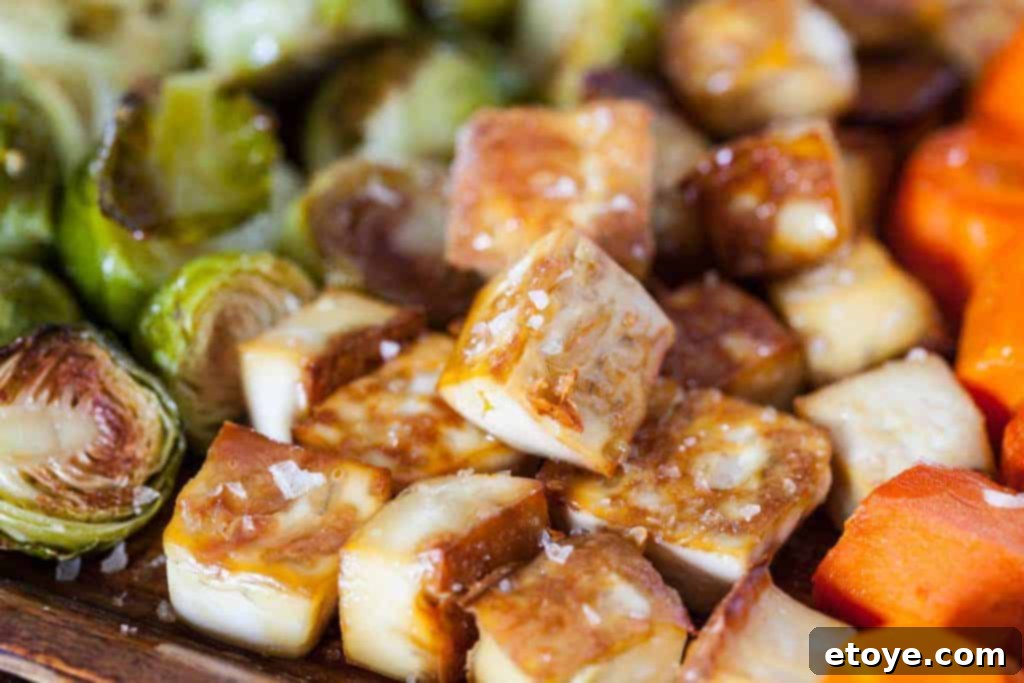
Embark on More Tofu Adventures with These Steamy Kitchen Recipes:
Ready to explore even more delicious ways to enjoy tofu? Dive into these fantastic recipes from Steamy Kitchen, designed to inspire and delight your palate:
- Green Goddess Tofu Bowl
- Chinese Braised Tofu with Ground Pork
- Crispy Tofu Buddha Bowl with Tangy Ponzu Sauce
- Tofu and Soba Noodles with Lemon Ginger Dressing
- Miso Soup with Tofu and Mushroom
- Thai Sweet and Sour Tofu
Conclusion: Embrace the Versatility of Tofu
Tofu, far from being a bland or intimidating ingredient, stands as a true culinary chameleon, offering endless possibilities for delicious, healthy meals. From its ancient origins in China to its burgeoning popularity in modern plant-based diets, tofu has proven its timeless appeal and incredible versatility. By mastering simple techniques like proper pressing, effective marinating, and choosing the right cooking method – whether it’s baking, pan-searing, grilling, or utilizing the convenience of smoked varieties – you can transform this humble bean curd into a star ingredient.
We hope this comprehensive guide has empowered you to confidently experiment with tofu in your own kitchen. Embrace its ability to absorb flavors, enjoy its diverse textures, and let it inspire creativity in your cooking. Tofu is more than just a protein; it’s a foundation for countless delightful dishes, proving that healthy eating can be both easy and incredibly flavorful. So, grab a block of tofu, get cooking, and discover why this plant-based hero deserves a permanent spot in your culinary repertoire!
